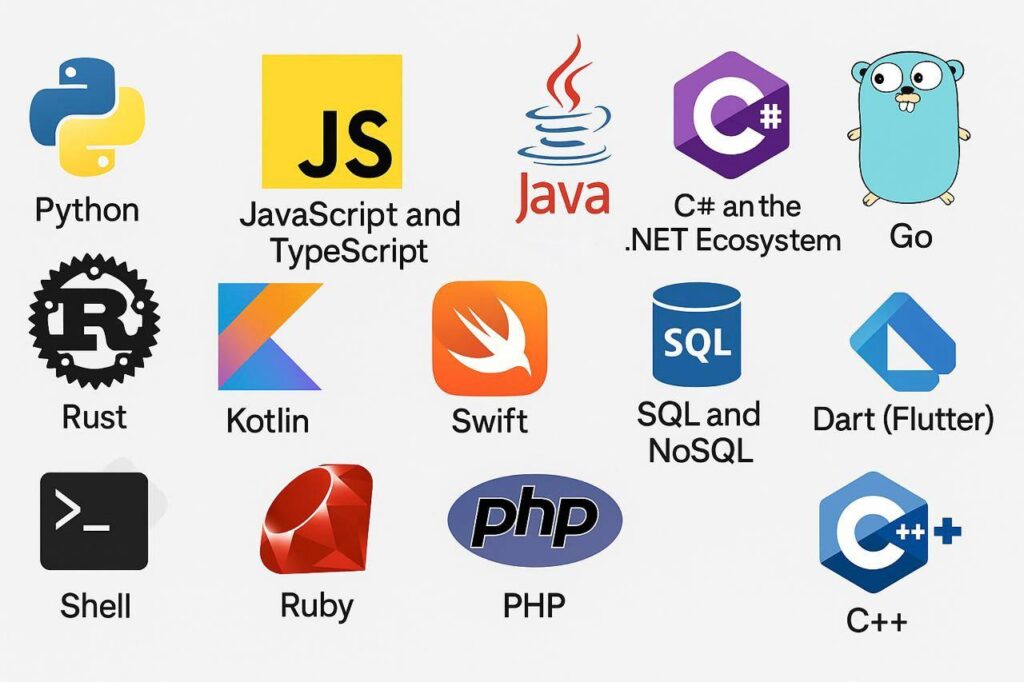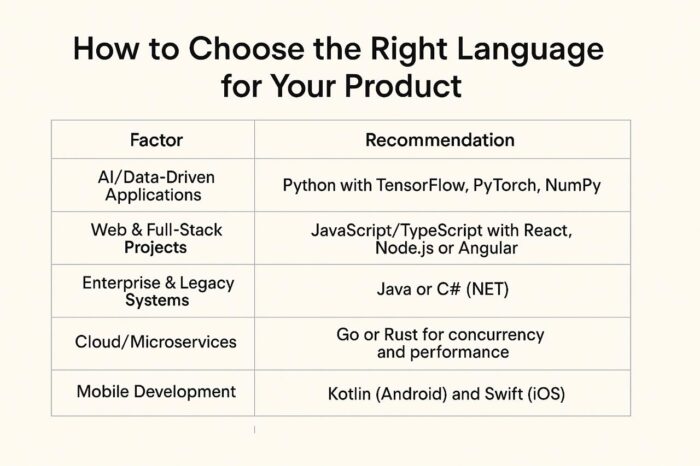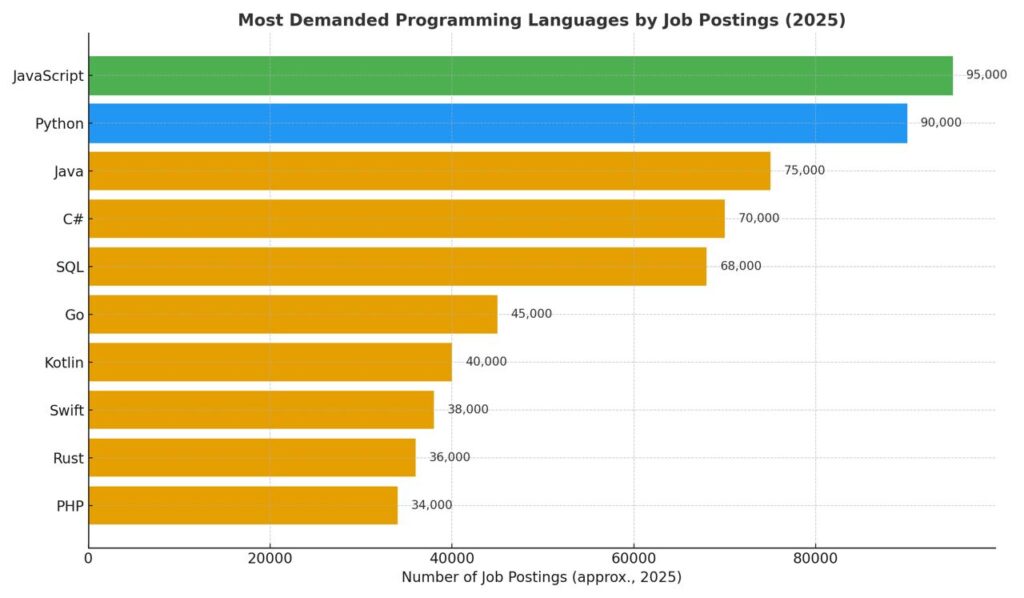The success of any digital product hinges not only on the technology stack or methodology, but on the people building it — and how they are structured. Poor communication, role overlaps, or misaligned responsibilities can lead to delayed launches, scope creep, and quality issues.
Choosing a programming language is no longer just a developer’s decision — it’s a strategic business move. In 2025, the right language accelerates development, reduces technical debt, and positions your product for growth. But with hundreds of options, which ones truly matter?
This guide explores 14 of the most in-demand programming languages based on current usage, developer trends, enterprise adoption, and long-term viability.
- The tech stack you choose affects everything from scalability and performance to hiring and time-to-market.
- In 2025, leading programming languages are those that support cross-platform development, AI integration, cloud-native infrastructure, and rapid deployment.
- Language choice should be guided by product goals, team expertise, ecosystem maturity, and long-term maintainability.
Programming Language Trends in 2025
In 2025, programming languages are no longer just technical tools — they have become strategic choices that directly impact business growth, scalability, and competitiveness. Companies are looking for technologies that support cloud-native systems, enable seamless integration with AI, ensure data security, and deliver flexibility across platforms.
The following languages represent the backbone of modern development, each serving a unique role in today’s technology landscape.

- Python: The AI and Data Powerhouse
Python continues to dominate fields such as artificial intelligence, machine learning, data science, and backend automation. Its clean syntax lowers the barrier for entry, while frameworks like TensorFlow, PyTorch, and Pandas make it indispensable for building predictive models, natural language processing systems, and big data pipelines. Businesses in healthcare, finance, and e-commerce rely on Python to create intelligent, data-driven solutions that drive real ROI. - JavaScript and TypeScript: Still the Web Standard
JavaScript remains the foundation of web development, while TypeScript has emerged as the preferred choice for enterprise-scale applications due to its strict typing and maintainability. Together, they power SaaS platforms, mobile-first solutions, and progressive web apps. Frameworks like React, Angular, and Vue continue to evolve, enabling companies to deliver fast, responsive, and scalable applications. TypeScript, in particular, is becoming a non-negotiable requirement for large, distributed teams that need clean, predictable codebases. - Java: The Enterprise Cornerstone
Java remains essential for large-scale enterprise systems, fintech platforms, and Android applications. Its reputation for stability, backward compatibility, and strong ecosystem ensures its continued dominance. In 2025, many organizations are modernizing their legacy Java applications by migrating them to microservices while maintaining the reliability that has made Java a corporate favorite for decades. - C# and the .NET Ecosystem
C# plays a critical role in building desktop applications, enterprise software, and video games via Unity. The growth of .NET Core and .NET 6+ has allowed developers to create truly cross-platform solutions. Companies in industries like gaming, finance, and logistics use C# to deliver secure, scalable products integrated seamlessly with Microsoft’s cloud ecosystem. - Go (Golang): Built for the Cloud
Go has become a first choice for microservices, distributed cloud infrastructure, and DevOps tools. Its speed, simplicity, and powerful concurrency support make it ideal for modern, high-load applications. Companies such as Google, Uber, and Dropbox have standardized on Go to build systems that can process millions of concurrent requests without performance bottlenecks. - Rust: Safety and Speed Combined
Rust is gaining traction in domains where performance and security are equally critical — from blockchain networks to embedded IoT systems. Unlike C++, it ensures memory safety without sacrificing execution speed, making it a go-to for industries that require resilience, such as cybersecurity, automotive, and fintech. In 2025, Rust is no longer experimental — it’s production-ready and increasingly mainstream. - Kotlin: Beyond Android Development
Originally designed for Android, Kotlin has expanded into cross-platform and server-side development. With Kotlin Multiplatform, businesses can now build apps that share code across iOS, Android, and even desktop platforms. Its concise syntax and full Java interoperability make it an efficient and modern alternative in ecosystems previously dominated by Java. - Swift: Powering the Apple Ecosystem
Swift has become the default choice for iOS, macOS, and Apple’s expanding ecosystem, including AR/VR and wearable devices. Known for speed and safety, Swift enables businesses to build secure, polished, and performance-driven applications that fully integrate with Apple technologies. - SQL and NoSQL: The Backbone of Data
Even in 2025, no application exists without a reliable database layer. SQL remains dominant for structured, relational data, while NoSQL is essential for real-time analytics, IoT systems, and unstructured datasets. Businesses combine both to support scalable, data-intensive applications that drive insights, personalization, and predictive analytics. - Dart (Flutter): Fast Cross-Platform Delivery
Dart, through the Flutter framework, is widely used for building MVPs and cross-platform mobile/web applications. Startups and enterprises alike value Flutter’s ability to deliver consistent user experiences across platforms with a single codebase, dramatically reducing time-to-market and development costs. - Shell, Bash, and PowerShell: The DevOps Backbone
Though not customer-facing, scripting languages like Bash and PowerShell remain essential in 2025. They power automation, infrastructure management, and CI/CD pipelines, ensuring reliability and speed in modern DevOps workflows. These “invisible” languages are foundational to any scalable cloud architecture. - Ruby: Rapid Prototyping and MVPs
Ruby’s popularity has declined compared to its peak, but it remains an excellent choice for prototyping, MVPs, and web startups. Ruby on Rails continues to enable rapid development, making it attractive to businesses that need to test ideas quickly before scaling. - PHP: Legacy but Relevant
Despite frequent criticism, PHP still powers a large share of the internet, especially content-driven platforms and CMS-based solutions like WordPress. In 2025, PHP is less about innovation and more about modernization and support, ensuring the stability of countless existing systems. - C++: The Language of High Performance
C++ remains unmatched in performance-critical applications such as gaming engines, real-time simulations, and embedded software. In industries like automotive, aerospace, and entertainment, C++ continues to deliver where low latency and maximum speed are non-negotiable.
Need help choosing the right language or structuring your development team?
Contact UsHow to Choose the Right Language for Your Product
Choosing the right programming language in 2025 is not only about developer familiarity—it’s about aligning your technology stack with the specific needs of your product and market. Each language carries strengths and trade-offs in terms of scalability, ecosystem support, speed of development, and future-proofing. Making the wrong choice early on can lead to costly rewrites, integration hurdles, or performance bottlenecks down the line.
The selection process should be guided by business objectives, target users, and system requirements, rather than popularity alone. For example, an AI-driven healthcare platform will benefit from Python’s machine learning ecosystem, while a financial institution running mission-critical services may prioritize Java or C# for their proven reliability and compliance support. Similarly, startups focusing on rapid prototyping and user-facing products often opt for JavaScript/TypeScript, which enables faster iteration cycles with large developer communities to draw from.
Another important factor is talent availability. Even the best technology stack can fail if it’s difficult to hire and retain engineers who know how to use it effectively. That’s why market demand and community size should weigh into the decision alongside performance benchmarks.
Finally, integration with cloud-native systems, DevOps pipelines, and cross-platform capabilities has become a core requirement. Languages like Go and Rust are increasingly preferred for microservices and performance-critical modules, while Kotlin and Swift dominate the mobile ecosystem.
Here’s a concise framework to guide the choice of programming language based on product type and goals:

Make your decision based on
- Business goals
- Developer availability
- Community and ecosystem
- Integration with legacy systems
- Maintenance and scalability needs
Most Demanded Programming Languages by Number of Jobs
The global job market is one of the clearest indicators of how programming languages are valued in real-world applications. By 2025, the demand for developers is shaped not only by technical trends but also by the long-term adoption of languages across industries. Hiring patterns show which skills businesses rely on most to build, scale, and maintain modern software ecosystems.
Aggregated job board data and industry hiring reports confirm that JavaScript, Python, Java, and C# dominate the employment landscape. These languages are firmly embedded in enterprise workflows, cloud-native systems, and web or mobile applications. At the same time, niche but fast-growing languages like Go, Kotlin, and Rust are gaining traction, particularly in high-performance, cloud, and security-focused environments.
JavaScript and Python lead the market in overall job postings, reflecting their versatility. JavaScript remains indispensable for front-end and full-stack development, while Python powers AI/ML, automation, and analytics. Java and C# continue to sustain enterprise ecosystems, especially in finance, logistics, and government software, where long-term investments in these stacks ensure ongoing demand.
Emerging languages are also making their mark. Go is increasingly sought after in DevOps, infrastructure, and high-load distributed systems. Kotlin is expanding beyond Android into cross-platform development, supported by its concise syntax and enterprise adoption. SQL and NoSQL expertise, while not standalone languages in the traditional sense, remain universal requirements—no matter the project domain, data handling remains fundamental.

Key Observations:
- Versatility is king: Developers proficient in multiple languages (e.g., Python + SQL + JavaScript) command higher salaries and greater project opportunities.
- Enterprise anchors remain stable: Java and C# continue to thrive due to their established ecosystems in banking, insurance, and enterprise SaaS.
- Cloud and mobile drive new demand: Go, Kotlin, and Swift are expanding in job listings as companies modernize infrastructure and mobile strategies.
- Databases remain critical: SQL’s consistent demand demonstrates that data expertise is inseparable from development roles.
In short, while newer languages are steadily rising, the backbone of software employment still relies on a combination of time-tested enterprise languages and versatile general-purpose tools.
Conclusion
In 2025, the choice of programming languages for your tech stack is more than a matter of developer preference — it’s a strategic business decision. The languages leading in job market demand, such as JavaScript, Python, and Java, demonstrate both technological versatility and long-term stability, making them safe bets for most projects. Meanwhile, the rising adoption of TypeScript, Go, and Kotlin signals where innovation and specialized solutions are heading.
Selecting a tech stack aligned with current market trends ensures better talent availability, stronger community support, and a higher likelihood of long-term maintainability. By balancing established technologies with emerging languages, businesses can future-proof their software solutions, attract skilled professionals, and remain competitive in an evolving digital landscape.
Why Ficus Technologies?
At Ficus Technologies, we help startups and enterprises:
- Choose scalable, future-proof tech stacks
- Build custom solutions with top-tier engineering teams
- Align team structure, tools, and development workflows to business strategy
Whether you need full-cycle development or to modernize an outdated platform, our experts deliver results.
Ideally both. Languages like Python and JavaScript offer broad talent pools and versatility, while Go or Rust may bring performance advantages.
Yes. Many products use polyglot stacks. Prioritize interoperability and maintainability.
Yes, particularly in CMS ecosystems like WordPress. But for new builds, modern alternatives may offer more flexibility.
Ficus provides audits, migration strategies, and implementation support to ensure smooth modernization.
They’re gaining traction but won’t replace Java or Python entirely. Consider them for cloud-native or performance-intensive systems.








